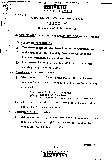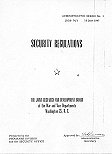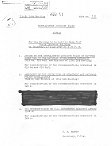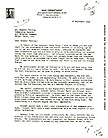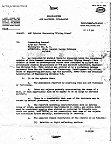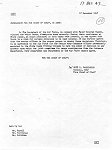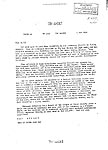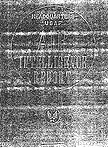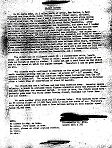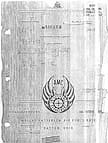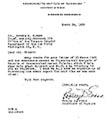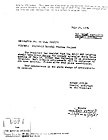![]() Joint R&D; Annexes, Agenda of 5th Meeting, December 1946 (8.5 MB*)
Joint R&D; Annexes, Agenda of 5th Meeting, December 1946 (8.5 MB*)
*please note this file may take several hours to download on a slow connection
also contains “R&D; Board: Directive Committee on Electronics,” 26 March 1948,
“R&D; Board: Directive Committee on Biological Warfare,” 18 February 1948, and the “JRDB Personnel Roster,” 22 January 1947
![]() Joint R&D; Board Security Regulations, 15 June 1947 (9.8 MB*)
Joint R&D; Board Security Regulations, 15 June 1947 (9.8 MB*)
*please note this file may take several hours to download on a slow connection
![]() Intelligence Advisory Board, 14th Meeting, 17 July 1947 (20k)
Intelligence Advisory Board, 14th Meeting, 17 July 1947 (20k)
From Record Group 353, Entry 411-413 Box 96 Interdepartmental committees comes another smoking gun memo. The Central Intelligence Group (CIG) had an Intelligence Advisory Board IAB, which held its 14th meeting on Thursday, July 17th 1947. The agenda memo shows one blacked out agenda item number three and none of the associated tabs are declassified yet. If you believe that the Roswell event or New Mexico crashes of early July 1947 are real then this was the first official meeting of the IAB and logical the event(s) would have been thoroughly discussed. This document does not preclude that conclusion.
![]() Zimmerman to Twining, Advanced Study Group, 12 September 1947 (122k)
Zimmerman to Twining, Advanced Study Group, 12 September 1947 (122k)
The Advanced Study Group is a likely area for UFO crashed hardware investigation and the genesis of reverse engineering. General of the Army Dwight D. Eisenhower, who was then Chief of Staff, established the group in 1947. Cloistered within the Air Materiel Command, it was headed by Don Zimmerman. Zimmerman had the resources, talent, and charter to research the cutting edge of aviation and space.
The contents of the file folder in Record Group 165 at the National Archives are missing, and declassification requests as of March 2001 have not yielded any further information. However, following is a short history of what we do know about the group:
The initial mission of the Advanced Study Group was to develop national security concepts in light of the revolution in warfare brought about by the onset of the atomic age. The Group was elevated to the Joint level with the creation of the Department of Defense, leaving a vacuum within the Army for independent and long-range thinking.
When the Army War College was reestablished in 1950, an Advanced Studies Group was chartered to consider strategy and land power. The Group evolved into the Advanced Studies and Doctrine Division within the faculty of the College. As part of an Army-wide reorganization in 1962, the Division became the U.S. Army Combat Developments Command Institute of Advanced Studies, addressing strategic questions, as well as those of organizing, equipping, and preparing the Army to fight. The 1971, the mission became exclusively strategic, and the Institute received its present name.
Another Army reorganization, in 1973, brought both the U.S. Army War College and the Strategic Studies Institute (SSI) under the Deputy Chief of Staff for Operations and Plans, and SSI became a War College department. More recently, the Institute has developed a dynamic and growing relationship with the Joint Staff, the National Defense University’s Institute for National Security Studies, and the Center for Strategic Leadership (including its Peacekeeping Institute) at Carlisle Barracks. SSI continues to provide an analytical capability within the Army to address strategic and other issues to support Army participation in national security policy formulation.
The group was charged with the task of radically rethinking Army doctrines that had been built up over the years and turning up suggestions for future warfare. Zimmerman was chairman. The others were Col. George W. Beeler, who had ranked second in the West Point graduation class of 1933, and Col. George Madison Jones, a paratrooper with a brilliant combat record and a Distinguished Service Cross. The group had entree into the highest scientific and military circles in the country and communicated with any other authorities it pleased. All that security permits to be disclosed about the reports is that they had a profound effect on military methods and thinking that have developed since then.
The Advanced Study Group is now known as the Joint Advanced Study Committee of the Joint Chiefs of Staff, with representatives from all three of the armed services. The security lid covers not only their work but also their identity as long as they are members.
![]() Air Materiel Command (AMC) Opinion Concerning “Flying Discs,” 23 September 1947 (67k)
Air Materiel Command (AMC) Opinion Concerning “Flying Discs,” 23 September 1947 (67k)
Found at the National Archives in Record Group 341 by many researchers, at least a decade ago, this three page opinion is unequivocal statement for the reality of Flying Discs and UFOs. “The phenomenon reported is something real and not visionary or fictitious.” Note that this is a Secret memo and deals with the sighting data alone and makes no direct reference to other data such as crashes. However, the opinion does clearly state “the lack of physical evidence in the shape of crash recovered exhibits which would undeniable prove the existence of the objects.” Is this in conflict with the other memos that support crash retrievals? No, not at all. This is a secret perfunctory memo and could be an effective cover story if leaked to Soviet Intelligence. Although the memo was signed by Twining it was coordinated with many others at AMC Col, Moore – Chief of the Aircraft laboratory, DA Dicky – Chief of the Propeller laboratory, General DL Putt – Engineering Division, Col. Minty – Chief Power Plant Laboratory and General Bevtual of T-3. The net result of this memo is that the government has confirmed the validity of the phenomenon and later goes on to establish programs Sign, Grudge, and Bluebook on the Secret level while at the same time developing a Top Secret Majestic program to deal with the super sensitive aspects of dead ET bodies and crash wreckage analysis.
![]() Vandenberg to Army Chief of Staff, 17 December 1947 (20k)
Vandenberg to Army Chief of Staff, 17 December 1947 (20k)
This document, found at the National Archives, RG 341, Entry 174, Box 141, is nearly identical to a leaked document we received, showing the same language in Paragraph 1 but an additional clarifying paragraph has been added which states: “This agreement concerns only decisions on joint range problems and does not extend into command and administration matters at Alamogordo Air Base.” It is logical to believe that either Vandenberg or the Army Chief of Staff upon seeing or reviewing the first memo might say “we need to clarify this so that no one misconstrues our intent and screws up the basic functions of Alamogordo Air Base.”
![]() U.S.A.F. Memo Regarding Swedish Air Intelligence Service, 4 November 1948 (48k)
U.S.A.F. Memo Regarding Swedish Air Intelligence Service, 4 November 1948 (48k)
This National Archives declassified Top Secret memo dated 4 Nov 1948 clearly establishes that the U.S.A.F. is “concerned by the recurring reports of flying saucers…one was observed hovering over Neuibiberg Air Base for about thirty minutes.” The memo goes on to discuss a visit with Swedish Air Intelligence Service, the Swedes said that “reliable and fully technically qualified people have reached the conclusion that these phenomenon are obviously the result of a high technical skill which cannot be credited to any presently known culture on earth.”
![]() Air Intelligence Report #100-203-79: Analysis of Flying Object Incidents in the U.S., 10 December 1948 (3 MB*)
Air Intelligence Report #100-203-79: Analysis of Flying Object Incidents in the U.S., 10 December 1948 (3 MB*)
*please note this file may take up to 30 min. to download on a slow connection
This formally TOP SECRET report on the “Analysis of Flying Object Incidents in the U.S.” dated 10 December 1948 was declassified in March 1985. The handwritten memo routing slip states — “T.S. Control Note: All published copies of this document have been ordered destroyed. This document for record purposes only not to be disseminated.”
The twenty-three page report of which only sixteen pages are available is divided into four appendixes of which, Appendix D, “Flying Wing Type Aircraft,” is missing. The problem the report examines is the “patterns of tactics of flying saucers and to develop conclusions as to the possibility of existence.” Under possible origins of the unusual flying objects the report states: “It is evident from the performance characteristics attributed to the unidentified objects at this time that if they are foreign, they involve efficiencies of performance which have not been realized in any operational airborne device in this country. It would, therefore, be a mistake to analyze the technical aspects of the situation within the limits of our own knowledge of practical developments.” Although an interesting early classified report, the authors were seemingly not given access to the real evidence of the New Mexico incidents and confined their discussion to lights in the sky and radar-visual cases, many with highly credible witnesses.
![]() Research and Development Board: Committee on Basic Physical Sciences, 28 January 1949 (177k)
Research and Development Board: Committee on Basic Physical Sciences, 28 January 1949 (177k)
This declassified memo from National Archives Records Administration (NARA), by Clyde E. Williams dated 28 January 1949, discusses the program planning for metallurgical research and development. What is interesting is their focus on magnetic materials, high heat resistant ceramics, and metals/alloys with increased strength-weight ratios. This effort, although a logical extension of normal engineering processes, is the likely place were unusual materials from the New Mexico crash events of 1947 would have been analyzed and discussed. Of all the technology recovered in 1947 and earlier, the most basic from our physics understanding at the time would be the materials. It would be nearly impossible at that time to make any progress in reverse engineering neutronic engines, lasers, or fiber optics. However, the saucer skin might have been an easier target for investigation. Further research into this committee and associated panels may provide stronger links to the UFO reserve engineering efforts.
![]() White Sands Object Report, 27 April 1949 (180k)
White Sands Object Report, 27 April 1949 (180k)
In our on-going research of the 1st Annual Report, we have located three pages of official documentation that confirm the data contained in Annex C, Entry 10 of the report. The relevant section of the 1st Annual Report reads thus:
On 24 April 1949, engineers and technicians from the White Sands Proving Ground observed a elliptically-shaped object moving in an eastward course at very high altitude. The object was discovered while tracking a Skyhook balloon through a theodolite. The object appeared whitish in color and pale yellow at the tale end. The object was estimated to be two-and-a-half times as long as it was wide. It was difficult to see any structure of the object as it was moving at a very high speed. The object was observed through a theodolite for approximately one minute before disappearing in a steep climb. The object was estimated to be traveling at an altitude of over 60 miles.
The three pages of documentation available here on this case were found in the official UFO records of the Air Force’s Office of Special Investigations at the National Archives and Records Administration, Maryland. They are: (a) a 1-page report on the case and (b) a 2-page witness statement attesting to the reality of the event.
Project Grudge, August 1949
![]() Part 1 (18.9 MB*)
Part 1 (18.9 MB*)
![]() Part 2 (23.5 MB*)
Part 2 (23.5 MB*)
![]() Part 3 (23.0 MB*)
Part 3 (23.0 MB*)
![]() Part 4 (19.1 MB*)
Part 4 (19.1 MB*)
![]() Part 5 (15.6 MB*)
Part 5 (15.6 MB*)
![]() Part 6 (13.2 MB*)
Part 6 (13.2 MB*)
![]() Part 7 (6.2 MB*)
Part 7 (6.2 MB*)
![]() Part 8 (4.0 MB*)
Part 8 (4.0 MB*)
*please note this file may take several hours to download on a slow connection
Declassified on July 23, 1997, Project Grudge was originally released in August of 1949 as a SECRET Technical Report (NO 102-AC 49/15-100) by the headquarters of the Air Materiel Command, Wright Patterson AFB, Dayton Ohio. Approved by Lt. Col. Hemstreet and Col. Watson, it is 406 pages long and covers a large number of UFO sightings along with investigation analysis, conclusions, and supplementary reports. Overall, it is just the basic background work on pedestrian UFO sightings by many credible military witnesses. No discussion of crashes, alien bodies, or the other TOP SECRET material found in more classified reports — just the way you would expect it.
See the “Official UFO Investigations” section for a further discussion of Project Grudge.
![]() Blount–Evans and Evans to Blount memos, 10 March 1950 (173k)
Blount–Evans and Evans to Blount memos, 10 March 1950 (173k)
Found at the National Archives in Record Group 341, Entry 44, Box 127 this pair of memo’s and routing slip show clear linkage between MIT’s Department of Physics (Dr. Robley Evans) and Lt. Col. Robert H. Blount (Medical Corps), Chief, Medical Research Division part of the Office of the Surgeon General. Discussed is a RESTRICTED Psychological Analysis of Reports Unidentified Aerial Objects (UAO) prepared by the Aero Medical Laboratory at Wright Field and a new TOP SECRET report that is in the process of being published (March 1950). However, the most stunning aspect of these letters is a reference to “one of these so called flying saucers crashed in Mexico; however, the details are somewhat bizarre at this moment.”
![]() Joint Logistic Plan for “MAJESTIC”, 25 September 1952 (290k)
Joint Logistic Plan for “MAJESTIC”, 25 September 1952 (290k)
Three interrelated TOP SECRET Security Information memos were found in Record Group 218 — Joint Chiefs of Staff and titled: “Joint Logistic Plan for MAJESTIC.” Declassified in May 1976, before the first Majestic or MJ-12 documents related to UFOs ever surfaced publicly, the memos are dated September and October of 1952. The documents provide for a Joint Logistic Plan for MAJESTIC. The document states: “The following plans in support of MAJESTIC are now under preparation: A psychological warfare plan, an unconventional warfare plan, cover and deception plans, a civil affairs/military government plan, a command plan, a logistic plan, transportation guidance, to be included in the logistic plan, a map and chart plan and a communications plan.” Given the worldwide nature of UFOs and their priceless value if recovered, it is imperative that the J.C.S. would have a logistic plan to recover crashed saucers and pack them back to the U.S. In April of 1954 we see the more official Top Secret MAJIC Eyes Only Special Operations Manual (SOM1-01) as a more complete example of this recovery effort. This report by the Joint Logistics Plans Committee, although primarily a war plan, is clearly capable of supporting crash retrieval operations for UFOs.
![]() Cutler to Twining Memo, 14 July 1954 (136k)
Cutler to Twining Memo, 14 July 1954 (136k)
Discovered in National Archives Record Group 341, Headquarters of the U.S. Air Force in box 189 by William Moore and Jamie Shandera and later photocopied by archivist Ed Reese, it is a carbon in original form. It is original onionskin paper with FOX watermark appropriate for the era. The short memo notes a subject of NSC/MJ-12 Special Studies Project but does not explain what that is. Now we have clear evidence that there was a MJ-12 project and that both General Twining, President Eisenhower and Robert Cutler knew about it.
